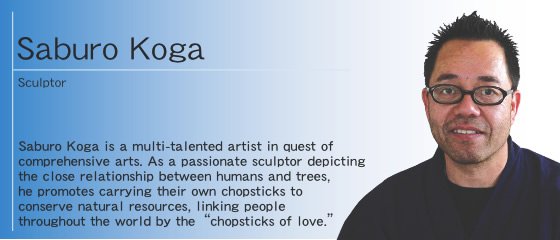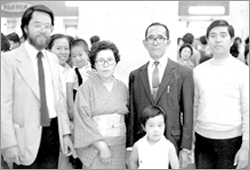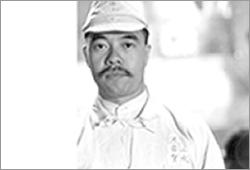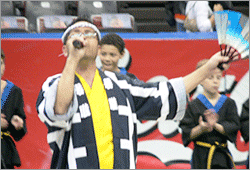YuYu interview Saburo Koga
 |
| —— What made you decide to become a sculptor? I am the youngest of four brothers. Our parents raised us while both of them had jobs. The family was not so well-off, so we often played with toys we made by ourselves, such as hard balls made out of mud and wooden bows. I’d been good at using small knives since I was fi ve or so. While playing like that, I naturally came to understand the joy of making things. When I was a third grader, we moved from Nagasaki to Yokohama. At the new school, my teacher complimented me on the composition of a poster that I’d made in the craft class. Then I started drawing pictures on my desk and carving things on pencils. I enjoyed doing so since that day. I believe the teacher’s words of encouragement made me a sculptor. —— Did you have something to do with America? 
In his childhood, he played with the toys that he made, 1954 (age 3)
My parents were survivors of the atomic bomb in Nagasaki. They often said in the Nagasaki dialect, “Kitsuka, Kitsuka,” meaning “tired, tired.” I’d heard A-bomb survivors often developed cancer, and that happened to my parents as well. My father died of lung cancer twenty-one years ago and my mother from cancer of the uterus, nineteen years ago. After the war, American armed forces were stationed in the bombed sites, Hiroshima and Nagasaki, for a long time. In Nagasaki, which had an exotic feel, I saw American soldiers until I turned five. You may not believe this, but in those days I was fair-complexioned and had reddish hair. American soldiers seemed to believe that I was half Japanese and half American. When I was walking with friends, for example, they would give me a 5-yen coin or a 10-yen bill, but only to me. In those days, 10 yen was a large amount of money, so my father often scolded me and said, “Where did you steal it?” That may have been more money than his daily wage as a shipbuilding engineer (laughter). For a child, I was pretty successful in communicating with American soldiers by using gestures. I liked the rhythm and intonation of English, so I often imitated lines from western movies. Thanks to that, my English teachers in junior high complimented me on my English pronunciation. —— When did you start as a professional sculptor? An acquaintance introduced me to a young sculptor in Nagasaki, Mr. Yohachi Kitamura and during spring break of my third year of junior high school, my parents and I visited him. He made a strong impression on me: his scary-looking face reminded me of an ogre; his hair curled naturally, just like the Big Buddha’s. I went to high school, because it was my mother’s wish, but Mr. Yohachi had told me that if I wanted to be apprenticed to him, I should do it soon. I was always thinking about his words, so I wasn’t able to motivate myself at all to do my high school studies, which were just like junior high school’s. Then, my father said to me, “It’s wonderful to have practical skills. Japan has imported materials and manufactured products, using its own technology. That’s how the country has managed to get out of the terrible situation that defeat in the war created. It’s good to create things. You should start soon.” So I voluntarily dropped out of high school after the third day to become Mr. Yohachi’s apprentice. —— Can you tell us about your apprenticeship? My typical day as fifteen-year-old apprentice of the passionate 35-year-old master was very long; I was on a minute-to-minute schedule. I’d wake up at 6:00 a.m. Then, I’d do the cleaning, go to the market, prepare breakfast and clean up, and finally start working at 8:30 a.m. Day and night, I did nothing but work in the kitchen. I studied drawing only before going to bed. The master taught me everything…no, that didn’t happen. Sculpture could not be systematically taught, so an apprentice had no choice but to learn it by literally “watching” the master. So I continued watching the master and observing how he used his fingers and tools. In the third month, I felt homesick, but the joy of making things was stronger than my feelings of homesickness, so I didn’t run away. Although I had two days off a month, all I could do was to get my haircut and do my laundry. After five years, my apprenticeship was over. The master gave me a suit and a set of 200 carving knives, which were special ordered. The next year, I started working as a craftsman and receiving monthly wages, though it wasn’t much. —— How and why did you decide to come to the US? 
At a street performance in Yokohama, 1973
(age 22) In 1972, when I was 21, I became an independent professional sculptor based in Yokohama. I was engaged in creating custom- made sculptures for temples and private residences, as well as, making jewelry. One day, a painter, who had visited many places overseas because of his Lions Club activities, told me that I should go to the US. He said, “America is huge. The color of the sky in California is different from that in Japan." By then, certain aspects of the US society in those days, such as “hippies,” “Woodstock,” “the Peacock Revolution,” and “the Strawberry Statement,” had been known in Japan for a few years. I had gotten hooked on folk songs, having a guitar in my hand. His words made me feel closer to America. I also wanted to know how much I could do as a sculptor and to test my potential. So in 1976, I visited Los Angeles, partly as a vacation, but I had no idea about where to find work. I visited some Japanese construction companies and tried to advertise myself, showing pictures of my works. At one of those companies, I was told: "We may not be able to find customers who could afford such wonderful sculptures, but there may be some other needs. Would you be interested in working here?” I’d never thought about hearing such words. Promising that I'd come back to the US half a year later, I left the company. Then a Japanese employee followed me and talked to me. He told me that he'd been listening to our conversation. He said he was thinking about founding a company with his friends and asked me if I’d be interested in working with them. The new company would specialize in creating unique homes by buying properties and remodeling them with carvings and sculptures on the interior and exterior. I was attracted by the company’s mission, so I accepted the offer and went back to Los Angeles half a year later. —— Can you tell us what happened after you came to the US? Right after I came back to the US in 1977, that Japanese man unexpectedly disappeared. I wanted to make a living as a sculptor, but first I had to earn some income, so I did a variety of jobs working at a take-out food shop, a statue shop, as a sushi master, a tour guide, a sculpture teacher, a limousine driver, a dental technician, etc., etc. I once even appeared as an actor in a film directed by Steven Spielberg. It was a comedy named "1941,” which depicted an Imperial Japanese submarine suddenly appearing ff the coast of California right after the attack on Pearl Harbor. I was supposed to be an extra playing a crew member of the sub, with Toshiro Mifune playing the main character, but I guess I stood out too much. The director wanted me to do more, so I luckily signed a contract as an actor. I was given lines and played a high-ranking crew member of the submarine. My pay also changed, from $65 a day to $850 a week. It took two months to finish filming and I gained valuable experience. After that, I worked as a tour guide and using my Hollywood experience, I became a popular tour guide. —— Who was a big influence on you? 
Flying to the US from Haneda Airport, 1977
(age 26) When I was about ten years old, there was a big mansion being built which was on the way to my elementary school. Every time I passed the construction site, I saw a carpenter planing an alcove post smooth. Wood flakes were coming out of the plane, one after another; it was like magic. There was the aroma of fresh wood coming from the site. I liked the way and spirit of the carpenter when he shook off the wood flakes and how they danced in the air. It looked cool to me. While passing the site every day, I gradually became friendly with the master carpenter. He gave me wood wastes and flakes. I made a variety of things out of it. He taught me that trees change into new energy and that even cut trees get new life and continue living. I have always wanted to let others know how wonderful trees are, something I learned from the master carpenter. I’ve always had this feeling somewhere in my heart. —— Can you tell us about “the relationship between trees and relaxation”? Many people have stereotypical images of iron and wood, believing that iron is strong and wood is weak, but this is wrong. Reinforced concrete lasts for no more than 100 years. In contrast, natural wood lasts from 500 to 1,000 years, if it is used properly. Wood expands in a humid atmosphere and shrinks when it is dry. And, wood keeps living even when it is cut into tiny pieces. Whenever you look around, you see chairs, tables, pencils, chopsticks, toothpicks, and so on. There are no other resources like wood, which is so closely connected to humans. Each piece of wood has a different character: stubborn, hard wood; easy, soft wood; straight wood; crooked wood etc. It is very similar to people. It’s warmth gives people gentleness and peace of mind. Some wooden structures, such as Shinto shrines and Buddhist temples, are part of the cultural heritage of Japan. This is because there were people who felt vitality in trees, talked with trees, loved trees, and lived with Mother Nature. —— What is the “Make My Chopsticks Workshop” that you have started? It is a campaign raising awareness about carrying your own chopsticks to help conserve resources. Today, the Earth is facing a big crisis. Believe it or not, a soccer field sized lot of trees is cut down every minute of each day around the world. At this rate, all of the forests of the Earth will disappear within fifty years. Forests produce our fresh air and help in producing rains. Rainwater, as it is filtered through the soil, creates water containing plenty of minerals. This water drop by drop eventually forms a rivers, running into the oceans and nurturing our marine life. Meanwhile, trees, although cut down, continue to live and breathe, and if used properly, they can be used in our daily lives for many thousands of years. The question is, how can we thoroughly make use of trees’ abilities while at the same time conserve this vital resource? The mission for all of us living today is to find these answers. I launched my campaign after I met Mr. Hiromitsu Noriyasu, aka the “Tentsuku Man,” last year. He had been traveling all over Japan, promoting his “My Chopsticks Campaign.” I was deeply moved by his passion for the campaign. Following his stance, I started the “Make My Chopsticks Workshop” as well. “Let’s make your own chopsticks. When you eat at a restaurant, use your own chopsticks, instead of disposable chopsticks.” That’s the concept of the workshop. —— Among your own sculptures and carvings, which is your favorite? All of my works (laughter). In other words, I don’t have any “ultimately perfect” works. That’s why I want to keep creating things, one after another. I’ll continue striving to create the “Ultimate Unfinished.” Well, actually, there is one that is special to me. After my father’s funeral at the crematorium in Japan, we found his Adam’s apple in his ashes. He had never been to the US, so I asked my brothers if I could have the Adam’s apple and take it with me to the US. Later, I created a statue of Buddha with a face resembling my father’s; I made a hole in the back of the statue, placed my father’s Adam’s apple in it, sealed the hole with a wood chip, and engraved his posthumous Buddhist name on the back. I’ve placed this statue of Buddha in a cabinet. I give it a glass of water and chant “Thank you” every day. Until last year, I’d tended to chant worldly wishes, such as “Let me win a lottery” and “Make me rich.” But, this year, I switched to “Thank you.” Actually, the energy of gratitude found in this simple phrase is more powerful than anything. —— Can you tell us about the “Nikkei Ondo” that you sang? 
Appearing as an actor in“1941”directed by Steven Spielberg, 1979 (age 28)
I used to live like a rolling stone, but was eventually able to settle down in California. It was because of the support of many Japanese Americans. As I grew older, I came to realize that I was able to settle in this country because there had already been a Japanese American community. I wanted to make my feelings tangible, so last year, on the occasion of the 150th anniversary of the commencement of exchanges between the US and Japan, I wrote a song. In the song, I put my gratitude for the pioneering Japanese immigrants who had created the foundation of today’s Japanese American community in the US. I also wrote the song hoping that the legacy of Japanese Americans will be passed down to the third, fourth, and later generations. I named the song the” Nikkei Ondo,” which has four verses. Mr. Hayato Murakami, an author, wrote the lyrics and I wrote the music. Last October, with the support of a number of people in various fields, we recorded the song and made a CD. The song was selected as the official theme song of the Japan Fiesta in San Diego that took place on March 26th of this year. On the event day, I had the first opportunity to sing the song in front of a big crowd. I sang from the bottom of my heart, wearing a costume that belonged to my father who was a rokyoku (a traditional Japanese music genre) singer. Meiji Taisho Showa no jidai (During the Meiji, Taisho, and Showa eras) Taishi idaite tada hitori (With ambition, you came alone) Yume to iu ji wo tsumekonde (Squeezing the world of dreams) Umi wo watatta toranku hitotsu (Into your suitcase, you sailed across the ocean) Doro wo tsukande tsukutte kureta (Grabbing mud, you created) Imin no rekishi kokoni ari (The history of immigrants living here) Aaaah, Aaaah, sore, sore, Nikkei Ondo de don! don! —— Can you tell us about your dreams for the future? 
Singing his “Nikkei Ondo” at the Japan Fiesta in San Diego, March 26, 2005 (age 54)
I believe that every phenomenon in this world is art. Spiritual energy from the Universe controls everything in this world. Human beings are also a component embedded in the Universe according to its law. I can’t help believing that our lives are connected by “invisible” strings. Mother Nature, the Earth, the Moon, the Sun, and the Universe--all are connected. I’d say the power that controls such connections is called “god.” Feeling the sedate “energy” from the Universe, tender and accepting of everything, I’ll continue sculpturing. I don’t want to limit myself only to being a “sculptor” just because I carve wood. I want to try a variety of things to further my career as an artist handling more comprehensive arts. Music is one of my hobbies and I’d like to do more music projects in the future. Actually, many prefectural associations have asked me to write different versions of the “Nikkei Ondo” in their dialects. I am pleased to learn that Hawaiians and Brazilians are also interested in the “Nikkei Ondo.” In the future, I’d like to go beyond the US and travel all over the world singing my gratitude for people of Japanese heritage. (05-16-2005 issue) |

